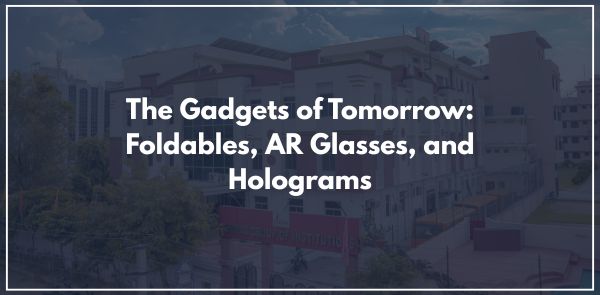
The world of technology is on the brink of a new era—one defined not just by faster processors and better cameras but by bold new form factors and immersive experiences. As we shift into the 2030s, three types of futuristic devices will redefine our interaction with the digital world—foldables, augmented reality (AR) glasses, and holographic displays. These gadgets are no longer the fantasies of science fiction—they are real, evolving, and increasingly central to the next wave of tech innovation. At Poddar College, one of the top 5 BCA colleges in Jaipur, we are excited to explore how these next-gen devices will shape the future of consumer electronics and prepare our students for the opportunities they present.
Once dismissed as a novelty, foldable devices have matured rapidly since their debut in the late 2010s. Pioneered by companies like Samsung, Huawei, and Motorola, foldables today boast more durable screens, refined hinge mechanisms, and sleeker designs. But what makes foldables more than a gimmick is their potential to bridge the gap between smartphones and tablets, eventually between phones and PCs.
Why Foldables Matter?
Foldables represent a fundamental shift in hardware design. Rather than locking users into one screen size, these devices adapt to the task at hand. Here are some of its applications:
As display technologies advance, future foldables may even roll, stretch, or expand dynamically—creating flexible devices that reshape themselves in real time depending on context. This adaptability could revolutionize mobile workspaces, education, and on-the-go content creation.
If smartphones brought the internet to our fingertips, AR (augmented reality) glasses aim to project it into our field of view. Unlike virtual reality, which immerses users in a fully digital world, AR layers digital information on top of the real world—offering a powerful blend of physical and virtual experiences.
Why Are AR Glasses More Than a Utility?
From experiments to everyday tools, while AR glasses like Google Glass and Microsoft HoloLens laid the foundation, the next generation is sleeker, smarter, and more socially acceptable. Major tech players, namely Apple, Meta, and Snap, are racing to release consumer-grade AR wearables that offer:
Imagine attending a meeting where your glasses display real-time transcriptions or highlight the speaker. Another scenario could be walking through a city with live contextual data floating in the air—restaurant reviews, directions, historical facts—all without ever pulling out your phone.
In professional environments, AR glasses are already transforming industries with the following applications:
In consumer contexts, expect gaming, education, and social media to become 3D, contextual, and location-aware—turning the world around you into an interactive playground. Additionally, IT colleges in Jaipur and other cities believe that AR glasses will transform the higher education sector in the future.
Few technologies capture the imagination quite like holograms. Long seen in movies like Star Wars or Iron Man, holographic displays are beginning to move from fantasy into function. While full 3D, floating holograms are still in the early stages, significant strides have already been made in the following:
Real-World Applications of Holograms
Holograms aren’t just about flash—they promise to revolutionize communication and visualization:
Startups like Looking Glass and Voxon and tech giants like Microsoft (with its Mesh platform) are actively developing holographic experiences for enterprise and entertainment. Meanwhile, Japan and South Korea are leading public infrastructure trials that embed holograms into urban navigation, customer service, and tourism.
Consider enrolling in a BCA course in Jaipur if you are looking to pursue a career in IT and work on these technologies.
Top MCA colleges in Jaipur believe mass adoption depends on solving key challenges–miniaturization, cost, content creation tools, and eye safety. However, with AI and 5G/6G connectivity enhancing real-time rendering and data transmission, consumer-friendly holographic devices may appear within the decade—especially in gaming, retail, and education.
What’s most exciting is not just the individual evolution of foldables, AR glasses, and holograms—but how they work together to build an immersive, seamless tech ecosystem. Imagine this scenario:
In such an environment, hardware boundaries blur. The user becomes the center of a personalized digital universe—one where tools adapt to context, motion, and emotion.
Despite the excitement, there are hurdles:
Yet, as with smartphones a decade ago, these are growing pains. With each iteration, the technology becomes more refined, accessible, and integrated into daily life.
Foldables, AR glasses, and holograms aren’t just cool gadgets—they’re the gateways to a post-smartphone world where computing is ambient, visual, and immersive. They’re reshaping how we learn, create, communicate, and experience the world.
At Poddar College, a top MCA college, we are committed to preparing our students for this exciting future. As developers build new apps, designers imagine new interfaces, and hardware continues to miniaturize and evolve, these technologies will become as common as smartphones are today. Whether it’s folding your phone into a workstation, viewing live navigation through your glasses, or chatting with a holographic friend, the future isn’t coming—it’s already unfolding in front of us.